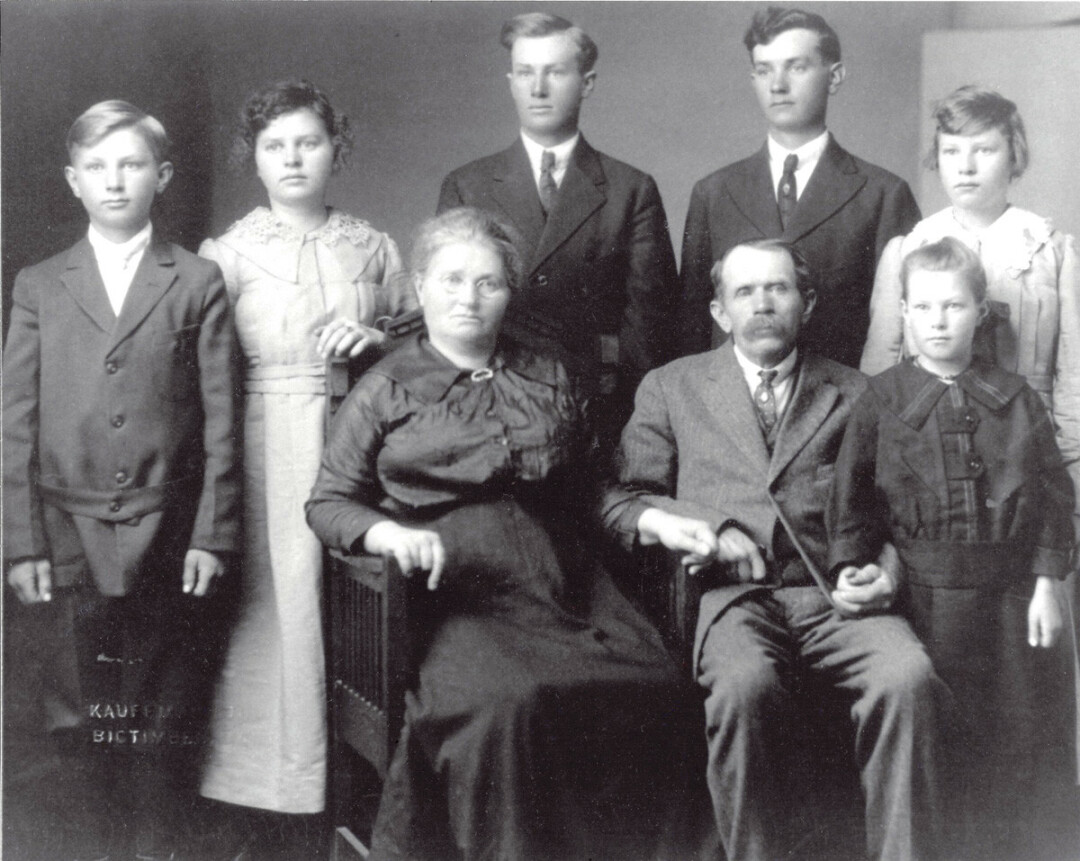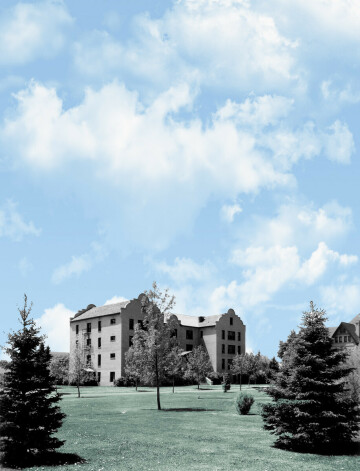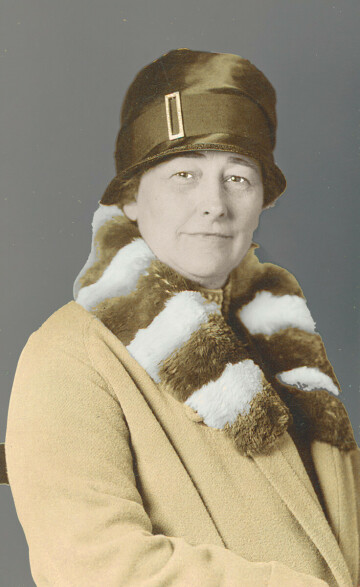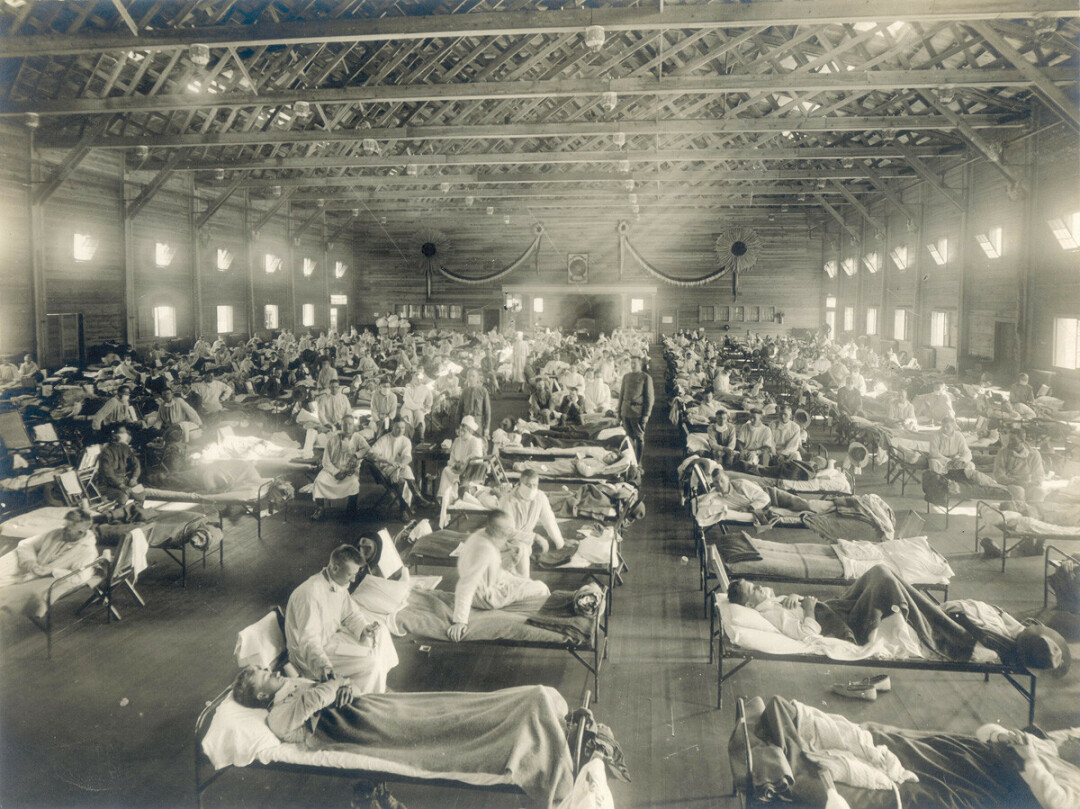The Pandemic of 1918 Still Affects Me, And I Didn’t Even Exist Then
Was there anything good about the flu outbreak of 1918?
Sunday Nov. 1st, 2020

I have been thinking about my mom, Gudruda Berg (1902-1996), and the flu epidemic (more correctly pandemic) of 1918. That autumn, my mom was sixteen-years-old and living in Montana State College’s Hamilton Hall in Bozeman. She had just started classes in MSC’s special Secondary School. Lo and behold, in mid-October, the College cancelled all classes because the flu was spreading so rapidly. People were dying a short four or five days after becoming ill. Especially young people. Hamilton Hall residents put themselves under a self-imposed quarantine until November 20, then went home. They returned to finish the quarter in January.2
Historian John Barry called the pandemic the deadliest in history. Influenza spread around the world, killing more in its wake in sheer numbers than any other disease before it. The lowest estimate is twenty-one million deaths, but epidemiologists surmise at least fifty million died. Half of those who died were in their twenties and thirties.
Montana did not escape the horrors. As state public health officials recently noted, “While Montana men and women risked their lives serving in World War I, their families at home also battled with a life-threatening enemy: an influenza pandemic that would claim thousands of lives across the state in just ten months’ time.”4
Goodness sakes, my mom had lost her own mother, Bertha, only a couple months before the quarantine. Sickened by a gall bladder infection, Bertha died at the family homestead about thirty miles northeast of Big Timber. What a tough time. Having her sister Elsie with her in Hamilton Hall was undoubtedly a wonderful comfort.
The Berg family had some college experience. Elsie and brothers Amos and Henry had taken home economics and agricultural classes the year before. Bertha and the three youngest children—Gudruda, Berent, and Mildred—lived in Bozeman that year. Henry, Elsie, and Gudruda returned for classes in the Fall of 1918. Henry played on MSC’s basketball team. Amos did not attend classes as he had enlisted in the army to fight in World War I.
While it is a mystery how they heard about the secondary school, Bertha and her husband, Gabriel, decided to take advantage of the educational opportunity. When MSC began in 1893, Montana Governor John Rickards appointed a young Danish immigrant named Peter Koch to the board. Luckily Koch had taken college courses in Copenhagen before he emigrated to America. He led the way to a special Secondary Course program that allowed eighth-grade graduates without any high school experience to enroll. They could attend fall and winter quarters for three years to learn and gain skills in agriculture, home economics and mechanic arts.
This brings me to one of those questions I wish I had asked Mom when she was alive. How and why did her parents decide to take their kids to Bozeman for these courses? I don’t think there were many Montana families that did. But four of the Berg children attended. Gudruda, the youngest of the four, only completed one quarter. Her education had been spotty before that, too. Raised in the sparsely populated area that became Golden Valley County in 1920, gave her limited schooling opportunities.
When the family moved to Bozeman in 1917, Gudruda enrolled in eighth grade. She was at least a year older than others in her class and she was a month late starting because the Berg family stayed on the farm until MSC’s quarter began. She described it as “tough.” When college classes ended in March 1918, Bertha and the kids moved back to the homestead. Mom finished the eighth grade at Cherry Creek School. Then she had to take the State Exams. With a big grin, she said later, “They passed me, but I don’t know why.”5
At MSC, Gudruda enrolled in English, art, textiles, cooking, gardening and physical education classes. The flu outbreak soon interrupted things though. When the quarantine began, classes were canceled and life on the campus changed. She fortunately escaped the disease; many others did not.
Montana, like elsewhere, was hit hard, ill-prepared to handle the Influenza A H1N1 virus. Public health officials, medical scientists, and clinical practitioners at the time had little knowledge or tools to arrest the spread of flu or treat the symptoms. This was before antibiotics and no one knew what caused the disease. Nurses and doctors aimed to control fevers and keep patients hydrated. They could do little more.
Without a cause and given only limited means of care, death spread across the state. A study by Montana Department of Public Health and Human Services officials Todd Harwell, Greg Holzman, and Steven Helgerson provides the most thorough accounting to date of the toll this flu outbreak took on Montanans. The first victim, Silva Whitmore, died in Red Lodge, succumbing to the illness on January 16, 1918. On February 25, MSC student Lloyd Kelly became the state’s fifth mortality and the first MSU student to die from the flu. He was gone five days after contracting the illness and its accompanying pneumonia. Others did not last that long. And mortality numbers increased. Between January and June of 1918—during the first of three waves of the pandemic—fifty-three Montanans died. Throughout the second and worst outbreak of the flu—from September to December 1918—there were 37,567 cases of the flu reported and 4,184 deaths. By the time this pandemic ended in June 1919, Montana influenza deaths totaled 4,237. These numbers are especially significant when you consider the state’s total population. In 1920, the Montana census recorded 584,889. The state had the third highest mortality rate in the Union. About eight in every 1,000 Montanans died. Only Pennsylvania and Maryland suffered more.7
Closing schools and quarantining healthy individuals curtailed some of the illness’s spread. On October 9, the State Board of Health allowed counties to close public places. Gallatin County, which experienced a death of one of its citizens in September 1918 and a number of cases of the flu soon after, closed all of its public gatherings, including schools, theaters, churches, pool halls, and soda fountains.8 Montana State College followed suit. MSC’s Dean of Women Una Herrick lived with the female students in Hamilton Hall. She steered the girls in a decision to quarantine themselves and not allow any contact with people outside. Then she continued their schooling as best she could.
Dean Herrick changed the daily schedule when the dorm went under quarantine. Breakfast was a little later so the girls could sleep in a bit. Instruction continued on a limited basis during the forenoon. There were no laboratory classes.
Afternoons were devoted to making things to help with the war effort. Students folded papers to make sputum cups, used to limit the spread of germs. Disposable handkerchiefs or tissues, like Kleenex, did not become common until 1926. The girls also made face masks. The first use of electric sewing machines on campus occurred in Hamilton Hall during this time. A logical guess would be that upper class students used them to make the masks. In the evenings, the girls gathered in the reception area for whatever musical or cultural programs they could create.
I marvel at the organizational and leadership skills of Dean Herrick. She and MSC President James Hamilton helped those in their charge cope with a frightening experience. Influenza outbreaks came in waves and the worst eruption was the autumn of 1918.
I marvel also at the creativeness, resourcefulness, and resilience of the students in spite of this death-threatening situation. Sometimes, too, their humor and hopes for a normal day also came through. During the flu quarantine, a tantalizing scene developed. The girls stepped outside for a walk late in the afternoon. The boys were out, too, practicing military drills. But they were not to talk. If the girls walked to the south, the boys marched north.9 This was so frustrating to the boys that one (or more) of them wrote a song about it. [I have read about the song, but simply cannot locate the exact source now.]
Student ingenuity can also be seen in the positive views of a young fellow who recorded his encounter with the flu in the 1920 MSC yearbook, The Montanan. “A ‘Fluey’ Diary” charts the student’s journey from registering for classes to “I have a little cold” to “I’m sure I won’t get it” to “This being sick isn’t any fun at all.”
I searched the yearbook for the author. No luck, but there is a broad disclaimer by the editorial staff, stating that because they were “restarting this tradition after the war, there may be lots of errors.” They added, “The ‘Flu’ is blamed for most everything so perhaps we can blame any failure of ours to the ‘Flu’.”
So, was “A ‘Fluey’ Diary” written by a single student recounting a real experience? Or was it written by more than one person? It really doesn’t matter because it captures some of the MSC flu experience and must be based somewhat on reality. I prefer to think it is authentic, a testament in ways to young people’s upbeat attitude.12
Don’t you just love it that so many young people blaze on in the face of adversity? It seems their positive attitude multiplies as numbers of them gather. Similarly, young people are admirable in applying their ingenuity and energy to working hard in educating themselves and gathering skills to help them craft a spot in this world. True today and true one hundred years ago. Looking back, even as war raged in Europe and Asia and the flu pandemic swept the whole Earth, young college students persisted when the flu hit campus and worked hard to meet the educational challenges at Montana State College.
I’ll close with two stories. Even while these young students overcame adversity, they did confront death and lots of it. On campus and off. The November 13, 1918 issue of the Weekly Courier, a Bozeman newspaper, reported: “All five children of Mr. and Mrs. Lewis Brown died of the flu, ages 15, 13, 11, 8 and 4. Mother and father not expected to survive. Family taken to detention hospital at Gallatin County High School when taken ill.” How tragic. I grew up in a family of five children. I can’t imagine such a lively setting wiped out just like that.
The other story is about my dad whose life, like my mom’s, was affected by the pandemic and the World War. He grew up in Illinois and had completed two years at the University of Illinois when he received orders to enter the Army in October 1918. He was to report to Camp Grant, but that was postponed because of the pandemic. I heard him say, “They were dying to beat the dickens up there.” U.S. Army records indicate that “At the peak of the outbreak, a soldier died about every twelve minutes at Camp Grant, Illinois.” The Armistice was signed November 11, 1918, and he did not have to go. It was too late for him to enroll for his junior year at the university. His dad had sold the farm because he thought his two boys were going to the army. With nothing to do, Dad went to Montana in March 1919 to work for his Uncle Asa Miller for the summer. It turned into a lifetime. He only returned to Illinois to visit.
So, if it hadn’t been for the flu pandemic and the World War, my parents would not have met and I wouldn’t be here to write this article. I would have hated to miss my life.
By the way, my wife, Alice, and I continue to get our flu shots each year.
About the authors: Jim Sargent followed his mother to Montana State College and graduated with an agriculture degree. His career in the Extension Service put him back on campus where he was the State 4-H Leader for years. He is the author of four books: Too Poor to Move, But Always Rich: A Century on Montana Land; Grandma Berta and a One-Room School: Influences of a Norwegian Immigrant in South Central Montana; An Airport’s Secret: A Surprise for August 2, 2085; and One Hundred and Ninety-Nine Years Late: A Party for Pomp’s First Birthday, A Lewis and Clark Story. His daughter, Linda Sargent Wood, followed in the family tradition and gained degrees in English and History at MSU. She is now a member of the history faculty at Northern Arizona University.
Sources
1 We thank Rachel Phillips, Research Coordinator at the Gallatin Historical Society in Bozeman, for her assistance in finding information on the flu in Gallatin County. The archivists in Special Collections at Montana State University Library were also very helpful and we are very appreciative.
2 For more on MSC’s closing and the Montana experience, see Pierce C. Mullen and Michael L. Nelson, “Montanans and The Most Peculiar Disease,” Montana, the Magazine of Western History 37 (Spring 1987): 50-61, especially 57; see also Volney Steele, “The Flu Epidemic of 1918 on the Montana Frontier,” Journal of the West 42 (Fall 2003): 81-90.
3 John M. Barry, The Great Influenza: The Story of the Deadliest Pandemic in History (NY: Penguin, 2005), see especially 4-5. The deaths of many young soldiers at Camp Grant emphasize the severity of the influenza. Fifty-one-year-old career officer Colonel Charles Hagadorn committed suicide on October 8, 1918, because he couldn’t bear to see the deaths of so many young men. Hagadorn had assumed the command of the camp on August 8, 1918, just before the flu struck; see Barry, Great Influenza, 212-219.
4 Todd S. Harwell, Greg S. Holzman, and Steven D. Helgerson, “‘No More War, No More Plague’: The Spanish Influenza Pandemic Toll on Montana,” Montana: Magazine of Western History (Summer 2018): 27-44, quote on 27. The caption appears under a picture showing the 163rd Infantry parading through Helena on October 24, 1917, shortly before leaving for France, 27.
5 Jim Sargent with Helen Pedula and Louie Strand, Grandma Berta and a One-Room School: Influences of a Norwegian Immigrant in South Central Montana (Great Falls, MT: Advanced Litho Printing, 2017), 27.
6John Russell’s notes from the Register of Deaths in Gallatin County in the archives of the Gallatin Historical Society Archives.
7 Harwell, Holzman, & Helgerson, “‘No More War, No More Plague,” 31-42; and Mullen and Nelson, “Montanans and The Most Peculiar Disease,” 50-61.
8 John C. Russell, “’In Flew Enza’: The Spanish Flu Outbreak, 1918-1920,” Pioneer Museum Quarterly: A publication of the Gallatin Historical Society 32 (Autumn 2009): 9-11.
9 “A ‘Fluey’ Diary,” 1918, 1920 Montanan (1919 printed by the Class of 1920), Montana State College Yearbook, Special Collections and Archives, Library, Montana State University, Bozeman. See the accompanying cartoon for the Oct. 17 entry for the marching of the boys and girls on different parts of campus.
10 Florence Temko, Paper Capers: All Kinds of things to Make With Paper (New York: Scholastic, 1974), 20.
11 The diary was reprinted in Montana: The Magazine of Western History 37 (Spring 1987): 62-64, with a note crediting a Student Army Training Corps (SATC) student as the author. We, however, have been unable to confirm this. MSU archivist Kim Allen Scott suggested comparing the 1920 Montanan staff with SATC cadets at the time. Duplication of names might give a pretty good idea. There is only one person whose name appears in both places: Zales Ecton of Manhattan. Ecton later became a United States Senator from Montana. If it wasn’t him, surely, he knew who was.
12 Others have also found the diary to be authentic. In the reprint of the work in Montana, the preface suggested that a SATC student wrote the piece. Pierce Mullen and Michael Nelson who had authored “Montanans and the Peculiar Disease” in the same issue, likely wrote this.
| Tweet |